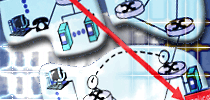Course Highlights
• The course covers the concepts, protocols and technologies driving today’s computer networks and the internet.
• Networking layers studied in a top-down fashion, using applications like email, Web, and down to data transmission in wired and wireless networks.
|
|
Topics
• Introduction: Circuit and packet switching, physical media DSL and Cable systems, internet protocol stack.
• Application Layer: The Web , FTP (File Transfer Protocol), Electronic mail, and DNS (Domain Name Service).
• Transport layer: UDP (User Datagram Protocol), reliable data transport, TCP (Transmission Control Protocol), flow control, congestion control.
• Network Layer: Datagram and virtual circuits, routing, IP addressing and transport, ICMP (Internet Control Message Protocol), RIP (Routing Information Protocol) and OSPF (Open Shortest Path First).
• Link Layer: Multiple access protocols, LAN addressing and ARP (Address Resolution Protocol), CSMA/CD and CSMA/CA protocols, Ethernet, Hubs, Bridges, and Switches, Wireless LANs, Wide Area Protocols - PPP, ATM and Frame Relay.
• Selected topics from multimedia networking, network security, and real-life networks.
|
![]()



